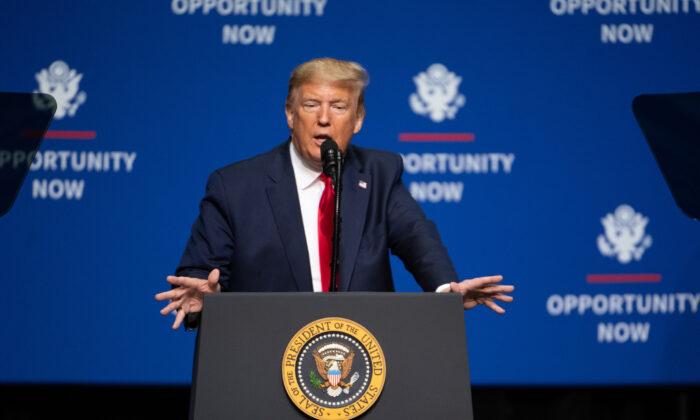WASHINGTON—President Donald Trump’s fourth budget resolution, which will be released Feb. 10, calls for substantial reductions to both discretionary and mandatory spending. The proposal includes deep budget cuts in foreign aid and environmental programs.
This year’s proposal, titled “A Budget for America’s Future,” includes $4.4 trillion in spending cuts over 10 years, according to a summary sheet provided to The Epoch Times.
The blueprint aims to reduce the deficit each year and achieve a balanced budget in 15 years.
“From day one, President Trump has taken deficits and spending very seriously—which is why the Trump administration has proposed more spending cuts than any administration in history,” a senior administration official told The Epoch Times.
Nearly $2 trillion of savings will be to mandatory spending, which includes entitlement programs such as Social Security, Medicare, and Medicaid. Another $2 trillion in savings will come from discretionary spending, and the rest will be interest savings, according to the plan.
Trump proposes to reduce foreign assistance by 21 percent, including cuts to United Nations programs. Eliminations of various programs and accounts are expected to save nearly $170 million compared to the 2020 enacted level.
The plan also proposes slashing the Environmental Protection Agency’s budget by 26 percent, by eliminating dozens of “wasteful programs.”
“We continue to think the environmental protection agency is bloated,” the official said.
The budget requests $740.5 billion for national defense in 2021, an increase of $2.5 billion over the 2020 enacted level. The plan also proposes to increase defense spending by nearly 2 percent on an annual basis after 2021 for a few more years.
The administration plans to request $2 billion in new funding from the Pentagon for the construction of a wall on the southern border, according to the official. That’s significantly lower than the money requested in previous years.
“Most critical features of the wall are being fully resourced as of right now,” the official said, adding that 80 percent of the wall that will be built is approaching being fully resourced.
In February last year, Trump declared the border situation a national emergency, which allowed him to redirect $6.7 billion from the Pentagon toward wall construction last year. The administration plans to shift an additional $7.2 billion this year.

Work Requirement Expansion
The president also proposes significant mandatory savings and reforms but protects Social Security and Medicare beneficiaries, the official said. The proposal includes nearly $130 billion in savings over 10 years from lower drug costs within the Medicare program.Another $300 billion savings is planned through implementing a 20-hour-per-week work requirement for the housing program and Medicaid, and expanding it within the food stamp program.
The Trump administration tightened work requirements for the food stamp program last year. This change alone has created $13 billion in savings over 10 years, according to the official.
Other proposals include student loan reform and site-neutral payments, the concept of paying the same amount for a service, regardless of whether the patient is treated at an outpatient hospital or a physician’s office, for example.
In light of the coronavirus outbreak in China, the budget prioritizes $4.3 billion in funding for fighting infectious diseases under the Centers for Disease Control and Prevention budget.

The budget also proposes maintaining security assistance to Ukraine at currently enacted levels, while increasing funding for Veterans Affairs, NASA, the Department of Homeland Security (DHS), and the National Nuclear Security Administration. It allocates no funding for Nevada’s Yucca Mountain nuclear waste repository.
The president’s budget for the Department of Housing and Urban Development is reduced by 15 percent, although the proposal includes $2.8 billion in homelessness assistance grants.
The budget proposes moving the U.S. Secret Service to the Treasury Department from DHS.
It also makes individual tax cuts that are set to expire after 2025 permanent.
The White House’s budget proposal sets high expectations for economic growth. The budget forecasts the economy will grow about 3 percent annually over the next decade, relying on the assumption that deregulation and other policies will have a long-lasting impact on the economy.
Congress has ignored Trump’s calls to slash federal spending before, and they’re likely to do so again. The proposal is generally viewed as a political messaging document.
Fiscally irresponsible spending bills over the past decade have dramatically boosted the debt, which recently surpassed $23 trillion.
Trump signed a bipartisan budget deal in August last year to raise spending caps by nearly $320 billion for fiscal years 2020 and 2021.
“I think at the end of that two-year deal, we’re going to have to really have a serious conversation about spending. And I think that’s what you’re hearing from the Hill,” the official said.





